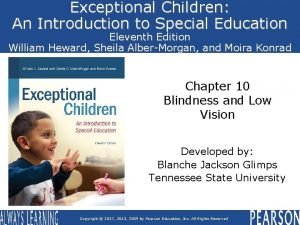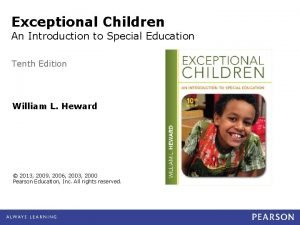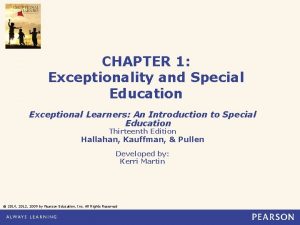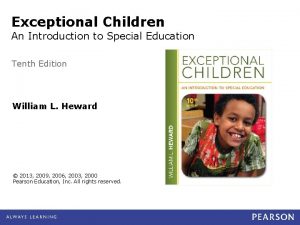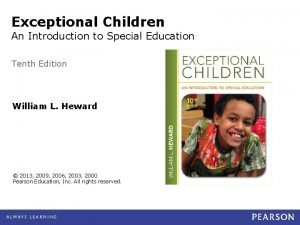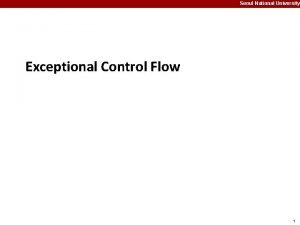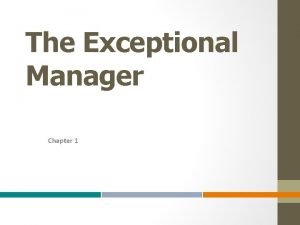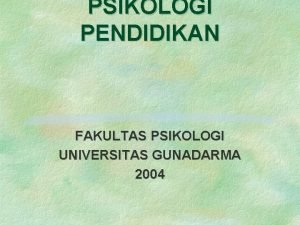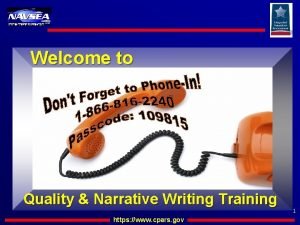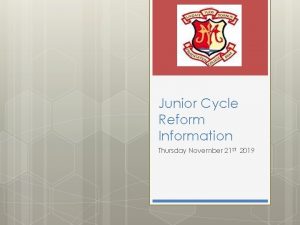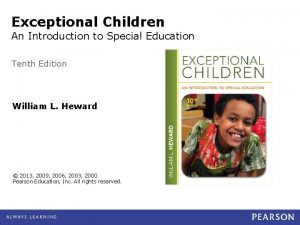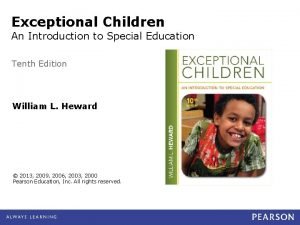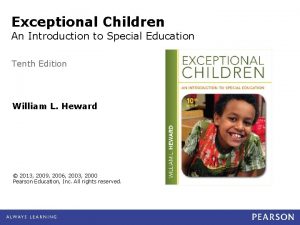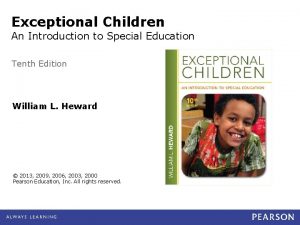Exceptional Children An Introduction to Special Education Tenth











- Slides: 11

Exceptional Children An Introduction to Special Education Tenth Edition William L. Heward © 2013, 2009, 2006, 2003, 2000 Pearson Education, Inc. All rights reserved.

Chapter 10 Blindness and Low Vision

Focus Questions What are the instructional implications of the three general classifications of visual impairments that educators use? How do blindness and low vision affect learning, motor development, and social interaction? Why is it important that teachers know about the types of visual impairments affecting children in their classroom? How do the educational goals and instructional methods for children with low vision differ from those for children who are blind? How might the educational placement of a student with visual impairments affect her opportunities to learn the expanded core curriculum of nonacademic skills necessary for overall success in life? Heward Exceptional Children, 10 e © 2013 Pearson Education, Inc. All rights reserved. 10 -2

Definitions of Visual Impairment The legal definition is based on visual acuity and field of vision • A person whose visual acuity is 20/200 or less after the best possible correction with glasses or contact lenses is considered legally blind • A person whose visual acuity is 20/70 in the better eye after correction is considered partially sighted for legal purposes IDEA definitions of visual impairments emphasizes the relationship between vision and learning • Totally blind: Receives no useful information through the sense of vision • Functionally blind: Learns primarily through the auditory and tactile senses • Low vision: Uses vision as a primary means of learning but may supplement by using tactile and auditory input Heward Exceptional Children, 10 e © 2013 Pearson Education, Inc. All rights reserved. 10 -3

Characteristics Cognition and language • Impaired or absent vision makes it difficult to see the connections between experiences • Abstract concepts, analogies, and idiomatic expressions can be difficult to understand without sight Motor development and mobility • Visual impairment often leads to delays and deficits in motor development Social adjustment and interaction • Children with visual impairments interact less and are often delayed in social skills • Many persons who have lost their sight report that the biggest difficulty socially is dealing with the attitudes and behavior of those around them Heward Exceptional Children, 10 e © 2013 Pearson Education, Inc. All rights reserved. 10 -4

Factors Influencing Social Involvement • Several factors influence the limited social involvement of children with visual impairments • Many cannot benefit from peers or adult role model because of the low incidence of the disability • The inability to see and respond to the social signals of others reduces opportunities for reciprocal interactions • Some individuals with visual impairments engage in repetitive body movements or other behaviors which places them at a great social disadvantage • Many report the biggest difficulty socially is dealing with the attitudes and behavior of sighted people Heward Exceptional Children, 10 e © 2013 Pearson Education, Inc. All rights reserved. 10 -5

Prevalence and Causes q. Fewer than 2 children in 1000 have visual impairments q. Many school age children with visual impairments also have another disability q. Causes of visual impairments • Refractive errors: Myopia (nearsightedness) and hyperopia (farsightedness) • Structural impairments: Cataracts, glaucoma, nystagmus, strabismus • Cortical visual impairments: Suspected damage to parts of brain that interpret visual information Heward Exceptional Children, 10 e © 2013 Pearson Education, Inc. All rights reserved. 10 -6

Educational Approaches Braille is the primary means of literacy for people who are blind • Braille is a tactile system of reading and writing composed of raised dots Tactile aids and Manipulative Technological Aids for Reading Print • Kurzweil 1000 - Optical character-recognition system • Hardware/software that magnifies screen images • Speech recognition software • Software that converts text files to synthesized speech Heward Exceptional Children, 10 e © 2013 Pearson Education, Inc. All rights reserved. 10 -7

Educational Approaches Special Adaptations for Students with Low Vision • Functional vision teaches the use of remaining vision Optical devices Glasses and contact lenses • Handheld telescopes or magnifiers • Closed-circuit television systems • Augmented reality systems • Approaches for Reading Print Approach magnification • Lenses • Large print • Classroom Adaptations Heward Exceptional Children, 10 e © 2013 Pearson Education, Inc. All rights reserved. 10 -8

Expanded Core Curriculum Orientation and mobility training (O&M) • Cane skills • Guide dogs • Sighted guides • Electronic travel aids Listening skills Functional life skills • Cooking • Personal hygiene • Shopping and financial management • Transportation • Recreational activities Heward Exceptional Children, 10 e © 2013 Pearson Education, Inc. All rights reserved. 10 -9

Educational Placement Alternatives 88% of children are educated in public schools 62% are members of general education classrooms 13% attend resource rooms for part of each day • Most students who are included in general education classrooms receive support from itinerant teacher-consultants • The most important factor to the successful inclusion of students with visual impairments is a skilled and supportive general education teacher 12% are served in separate classrooms 6% attend special day schools 4% attend residential schools Heward Exceptional Children, 10 e © 2013 Pearson Education, Inc. All rights reserved. 10 -10
 Introduction of exceptional child
Introduction of exceptional child Exceptional children an introduction to special education
Exceptional children an introduction to special education Exceptional learners: an introduction to special education
Exceptional learners: an introduction to special education Exceptional children 10th edition
Exceptional children 10th edition Exceptional children 10th edition
Exceptional children 10th edition Human genetics concepts and applications 10th edition
Human genetics concepts and applications 10th edition Exceptional control flow
Exceptional control flow Raleigh and rosse case analysis
Raleigh and rosse case analysis Exceptional manager
Exceptional manager Kategori exceptional people
Kategori exceptional people Cpars examples
Cpars examples Maths cba 1 ideas exceptional
Maths cba 1 ideas exceptional
